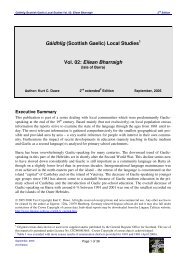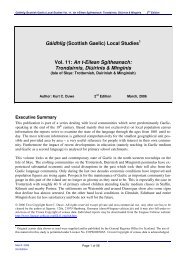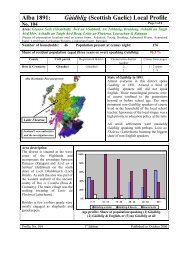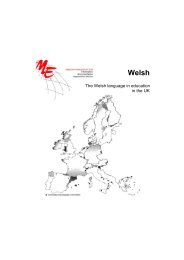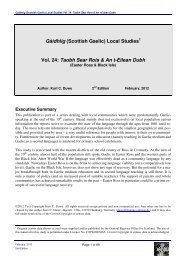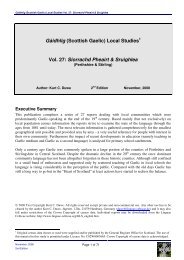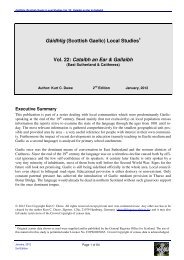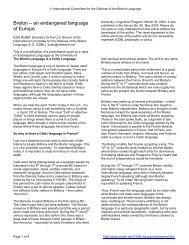1. Loch Ailleart - Linguae Celticae
1. Loch Ailleart - Linguae Celticae
1. Loch Ailleart - Linguae Celticae
Create successful ePaper yourself
Turn your PDF publications into a flip-book with our unique Google optimized e-Paper software.
Alba 1891:<br />
Gàidhlig (Scottish Gaelic) Local Profile<br />
No. 030<br />
Page 1 of 4<br />
Area: Ceann <strong>Loch</strong> <strong>Ailleart</strong>, Gleann <strong>Ailleart</strong>, Inbhir <strong>Ailleart</strong>, Poll Nis, Peighinn Meadhonach,<br />
Lagan, Glas na Ceàrdaich, Sloc, Mullach Buidhe, Easan, Meobal, Leitir Mòrair, Sgamadal<br />
(Names of enumeration locations used on census forms: Kinlochailort, Glenailort, Inverailort, Polnish, Penmeanach,<br />
Laggan, Glasnacardoch, Slock, Mullachbuie, Essan, Arganiskill, Meoble, Lettermorar, Scamadale & Sumisletter)<br />
Number of households: 47 Population present at census night: 246<br />
Share of resident population (aged three years or over) speaking Gàidhlig: 97.8 %<br />
County Civil parish Registration district Enumeration district Census form pages<br />
number<br />
Inverness-shire Arisaig & Moidart Arisaig<br />
3 1 – 5; 8 - 13<br />
4<br />
5<br />
1<br />
1 - 5<br />
Alba (Scotland): Past and present<br />
<strong>Loch</strong> <strong>Ailleart</strong><br />
State of Gàidhlig in 1891:<br />
Almost the whole resident population spoke<br />
Gàidhlig in the district. A majority of<br />
speakers was still monolingual especially in<br />
communities on the Àird Nis (Ardnish)<br />
peninsula and the southern shores of <strong>Loch</strong><br />
Mòrar. Only the generation aged between<br />
10 and 24 did show a majority for those<br />
who were (also) speaking English. Locals<br />
were slightly more likely to speak only<br />
Gàidhlig than people born in other parts of<br />
the Gaidhealtachd.<br />
Scotland’s new authorities<br />
and the investigation area<br />
Area description:<br />
The communities described here<br />
occupied the land around the<br />
northern part of <strong>Loch</strong> <strong>Ailleart</strong><br />
(<strong>Loch</strong> Ailort) on the northwestern<br />
coast of the Highlands.<br />
They included especially a<br />
number of crofting hamlets on the<br />
Àird Nis peninsula. In contrast<br />
only a handful of shepherds and<br />
gamekeepers inhabited some of<br />
the neighbouring glens towards<br />
Gleann Fhionghain (Glenfinnan)<br />
and <strong>Loch</strong> Mòrar.<br />
100%<br />
80%<br />
60%<br />
40%<br />
20%<br />
0%<br />
3 - 9 10 - 14 15 - 24 25 - 44 45 - 64 65+<br />
Gàidhlig a mhàin Gàidhlig & Beurla Beurla is eile<br />
Age profile: Share of population speaking (1) Gàidhlig,<br />
(2) Gàidhlig & English, or (3) no Gàidhlig at all<br />
Profile No. 030 1 st Edition Published in September 2005
Alba 1891:<br />
Gàidhlig (Scottish Gaelic) Local Profile<br />
No. 030<br />
Page 2 of 4<br />
Area: Ceann <strong>Loch</strong> <strong>Ailleart</strong>, Gleann <strong>Ailleart</strong>, Inbhir <strong>Ailleart</strong>, Poll Nis, Peighinn Meadhonach,<br />
Lagan, Glas na Ceàrdaich, Sloc, Mullach Buidhe, Easan, Meobal, Leitir Mòrair, Sgamadal<br />
Age<br />
Population enumerated Usually resident population (3+)<br />
Total Aged<br />
0-2<br />
Deaf<br />
&<br />
dumb<br />
Visitors<br />
etc. 3<br />
Total 4 Gàidhlig Gàidhlig<br />
&<br />
English<br />
Gàidhlig<br />
speakers<br />
(%)<br />
Total 246 15 0 6 225 124 96 97.8 %<br />
3-4 10 0 0 0 10 8 1 90.0 %<br />
5-9 17 0 0 0 17 10 7 100 %<br />
10-14 27 0 0 0 27 9 18 100 %<br />
15-24 46 0 0 2 44 13 28 93.2 %<br />
25-44 63 0 0 1 62 34 27 98.4 %<br />
45-64 42 0 0 1 41 31 10 100 %<br />
65+ 26 0 0 2 24 19 5 100 %<br />
Gender<br />
Female 125 6 0 4 115 70 44 99.1 %<br />
Male 121 9 0 2 110 54 52 96.4 %<br />
Place of birth<br />
Born in parish 184 11 0 3 170 101 69 100 %<br />
In neighbouring parish 1 38 3 0 0 35 14 17 88.6 %<br />
Gaidhealtachd elsewhere 2 19 0 0 1 18 9 9 100 %<br />
Other places 5 1 0 2 2 0 1 50.0 %<br />
Notes:<br />
1<br />
Parishes of Ardnamurchan, Ardgour (both<br />
Argyll); Glenelg, Kilmallie (both Inverness).<br />
2<br />
Other parishes in Scotland with more than 50 %<br />
Gàidhlig speakers in the 1891 census.<br />
3<br />
People described as visitors, boarders, lodgers or<br />
other similar terms.<br />
4<br />
Number of enumerated persons who were (1)<br />
older than 2 years of age, who were (2) not deaf<br />
& dumb and who (3) did not live only temporarily<br />
in the area.<br />
Gàidhlig a mhàin<br />
Gàidhlig & Beurla<br />
Beurla is eile<br />
Share of population speaking (1) Gàidhlig,<br />
(2) Gàidhlig & English, or (3) no Gàidhlig at all<br />
Background of Gàidhlig (Scottish Gaelic) Local Profiles:<br />
The 1891 census was the first such enumeration exercise with an unequivocal language question. After<br />
more than 100 years the original census forms are publicly available for detailed analysis. During research<br />
concerned with the “Gàidhlig (Scottish Gaelic) Local Studies” a vast number of such local statistics have<br />
been gathered about the Gàidhlig speaking population of Scotland in that year. As many of these results<br />
could not be included in the reports these concise fact-sheets are a welcome way to publish some of the<br />
“local gems”. More information is provided at http://www.linguae-celticae.org/GLP_english.htm .
Alba 1891:<br />
Gàidhlig (Scottish Gaelic) Local Profile<br />
No. 030<br />
Page 3 of 4<br />
Area: Ceann <strong>Loch</strong> <strong>Ailleart</strong>, Gleann <strong>Ailleart</strong>, Inbhir <strong>Ailleart</strong>, Poll Nis, Peighinn Meadhonach,<br />
Lagan, Glas na Ceàrdaich, Sloc, Mullach Buidhe, Easan, Meobal, Leitir Mòrair, Sgamadal<br />
Households<br />
Usually resident population (3+)<br />
Total Gàidhlig Gàidhlig &<br />
English<br />
Gàidhlig<br />
(%)<br />
<strong>Loch</strong> <strong>Ailleart</strong> 47 225 124 96 97.8 %<br />
Individual communities<br />
Ceann <strong>Loch</strong> <strong>Ailleart</strong> & Inbhir <strong>Ailleart</strong><br />
(Kinlochailort & Inverailort)<br />
Ceann <strong>Loch</strong> nan Uamh & Poll Nis<br />
(Kinlochnanuagh & Polnish)<br />
Lagan<br />
(Laggan)<br />
Peighinn Meadhonach<br />
(Penmeanach)<br />
Glas na Ceàrdaich<br />
(Glasnacardoch)<br />
An Sloc<br />
(Slock)<br />
Mullach Buidhe<br />
(Mullachbuie)<br />
Easan & <strong>Loch</strong> Eilde<br />
(Essan & <strong>Loch</strong> Eilt)<br />
Meobal<br />
(Meoble)<br />
Leitir Mòrair & Sgamadal<br />
(Lettermorar & Scamadale)<br />
Language of parents<br />
7 21 13 7 95.2 %<br />
7 28 18 9 96.4 %<br />
2 18 6 12 100 %<br />
7 44 22 22 100 %<br />
3 15 10 5 100 %<br />
3 13 8 5 100 %<br />
3 13 13 0 100 %<br />
4 17 2 13 88.2 %<br />
4 27 6 20 96.3 %<br />
7 29 26 3 100 %<br />
Both parents Gàidhlig speaking 20 115 59 52 96.5 %<br />
Single parent Gàidhlig speaking 7 42 25 17 100 %<br />
One parent Gàidhlig speaking 0 0 0 0 -<br />
No Gàidhlig speaking parent 0 0 0 0 -<br />
Households with no children (0-14) 20 68 40 27 98.5 %<br />
Occupation of head of household<br />
Crofter, farmer, fisherman, etc. 26 139 84 54 99.3 %<br />
Shepherd, gamekeeper or similar 9 37 15 19 9<strong>1.</strong>9 %<br />
Clergyman, teacher, physician, etc. 1 4 0 4 100 %<br />
Mason, carpenter, merchant, etc. 1 6 5 1 100 %<br />
Living on private means 0 0 0 0 -<br />
Manager, coachman, cook, etc. 4 24 6 18 100 %<br />
Worker, farm/domestic servant, etc. 6 15 14 0 93.3 %<br />
Remaining occupations 0 0 0 0 -<br />
© Text and statistics: Copyright Kurt C. Duwe. All rights reserved except private and non-commercial<br />
use. Any other use has to be cleared by the author Kurt C. Duwe, Jägerstr. 120a, 21079 Hamburg,<br />
Germany (duwe@linguae-celticae.de) and it may also fall under restrictions of the Crown Copyright of<br />
census data. Statistics have been derived from 1891 census returns published by the General Register<br />
Office for Scotland (GROS). The use of this material here is permitted under Licence No.<br />
C02W0003665. Crown Copyright of census data is acknowledged. The digital boundaries shown on the<br />
Scotland map are courtesy of Ordnance Survey as part of the Geography Products provided by GROS.<br />
Additional individual profiles may be downloaded from a special page on the <strong>Linguae</strong> <strong>Celticae</strong> website:<br />
http://www.linguae-celticae.org/GLP_english.htm
Alba 1891:<br />
Gàidhlig (Scottish Gaelic) Local Profile<br />
No. 030<br />
Page 4 of 4<br />
Area: Ceann <strong>Loch</strong> <strong>Ailleart</strong>, Gleann <strong>Ailleart</strong>, Inbhir <strong>Ailleart</strong>, Poll Nis, Peighinn Meadhonach,<br />
Lagan, Glas na Ceàrdaich, Sloc, Mullach Buidhe, Easan, Meobal, Leitir Mòrair, Sgamadal<br />
Place of birth and Gàidhlig speaking:<br />
Monolingual Gàidhlig speakers were<br />
predominant in the “local” population and<br />
amounted to 50 % among those born in the<br />
remaining Gaidhealtachd.<br />
100%<br />
80%<br />
60%<br />
Notes:<br />
1<br />
Born either in Arisaig & Moidart or in the<br />
adjacent parishes of Ardnamurchan, Ardgour<br />
(both Argyll); Glenelg, Kilmallie (both<br />
Inverness).<br />
2<br />
Born in other parishes of Scotland with more<br />
than 50 % Gàidhlig speakers in the 1891 census.<br />
40%<br />
20%<br />
0%<br />
Nearby Gaidhealtachd Elsewhere<br />
Gàidhlig a mhàin Gàidhlig & Beurla Beurla is eile<br />
Speakers according to place of birth (1) nearby 1<br />
(2) in remaining Gaidhealtachd 2 , or (3) elsewhere<br />
Remarks:<br />
<strong>1.</strong> Only five persons were reported as not Gàidhlig speaking. Obvious returns in this respect<br />
came from the teacher (born in Ft. Augustus) at Meobal and from a gardener of Irish birth.<br />
The remaining three “no Gaelic” returns came from a three year old child and two servants<br />
(15 and 19 years old) who were born in nearby Mòrar. At least the latter persons, however,<br />
were very unlikely unable to speak the community language of their childhood. Perhaps they<br />
did not use the language in front of their masters (who normally provided census<br />
information as heads of household to the enumerator).<br />
2. In original census report terms the district had a population of 246 persons of all ages. 96<br />
enumerated inhabitants spoke “Gaelic and English” and 142 were counted as monolingual<br />
Gàidhlig speakers. This lead to an “official” share of Gàidhlig speakers of 96.7 %.<br />
Accordingly this percentage was an under-estimate of <strong>1.</strong>1 %.<br />
Profile No. 030 1 st Edition Published in September 2005



